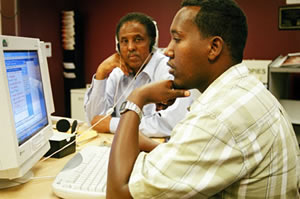A letter to the StarTribune newspaper last spring about the impending arrival of 5,000 Hmong refugees in Minnesota raised concerns voiced often in neighborhood cafes and public forums.
"How much money will they be given from our coffers?" wrote the woman from suburban Minneapolis. "What will be affected by their presence, i.e., Medicaid, Medicare, Social Security, etc.? If they are already of Social Security age, what will they get that I and others worked for?"

The Pelican Rapids (Minn.) Public Library offers computer technology
as well as traditional services to the community's new immigrants.
She needn't fret about Hmong from Wat Tham Krabok jeopardizing her retirement; 60 percent of the refugees from the camp are under age 18. But what about the other public costs of immigration—the impact on schools, health care, welfare programs, law enforcement and other tax-funded amenities that government provides to—ahem, native—citizens and businesses? The question seems particularly apropos today, as state and local governments throughout the district struggle to balance their budgets after a lengthy economic downturn.
It's undeniable that immigrants represent a cost to society, at least in the short term. In the region and nationwide, they are poorer, less skilled and more likely to require public assistance than native-born Americans. A fedgazette analysis of 25 rural counties in the district with the highest concentrations of immigrants from Africa, Asia and Latin America found high poverty rates among the foreign-born (see table). Over one-fifth of immigrants living in those nonmetro counties in 1999 fell below the federal poverty line.
The burden of lifting the fortunes of the foreign-born and integrating them into the economy falls heaviest on states and cities that have absorbed the biggest inflows of immigrants. National studies have shown that while immigrants generate significantly more in federal taxes than they consume in public services, those tax dollars are unevenly distributed among states and local communities. As a result, taxpayers in high-immigration areas pay a disproportionate share of the tab at state, county and city levels for services provided to immigrants.
Businesses and native-born residents in the Twin Cities will bear much of the cost of basic schooling, English-language instruction, job training, medical screenings, cash assistance and other services for the Hmong coming to St. Paul. In June Congress agreed to provide $22 million in refugee resettlement funds this year to help pay for Hmong refugees in Minnesota, Wisconsin and California. But Minnesota elected officials, including U.S. Sens. Mark Dayton and Norm Coleman, have said that isn't enough; they're pushing for an extra $10 million targeted at Hmong resettlement.
Hennepin County estimates that it will need $7.5 million in the next year to support about 1,500 refugees. Neighboring Ramsey County, the expected destination for 60 percent of the Wat Hmong, had not issued cost projections as of July. Whether preparing immigrants for a life in the district is worth the cost depends on your point of view. That cost can be seen as an economic drain, a waste of resources that could be better spent on improved health care and schooling for natives or road construction or environmental protection. Alternatively, spending money on immigrants can be viewed as an investment, one that will pay economic dividends years from now.
Counting the cost in Fargo ...
The Fargo-Moorhead area has absorbed more than 3,000 immigrants over the past 13 years. The public costs incurred by those new residents are real and quantifiable, line items in the budgets of local schools, clinics and social service agencies. Replicated in dozens of cities and towns across the district, they amount to an immediate and substantial cost to U.S. taxpayers.
Refugees in Fargo are heavy consumers of public assistance, most of it provided by the federal government during the first eight months of settlement. A 2002 study by North Dakota State University in Fargo estimated that a refugee family of four costs the taxpayer $21,965 during that initial resettlement period. That figure includes $8,220 in federal cash assistance, $1,900 in food stamps and $11,200 in Medicaid. After eight months, still-needy refugees can get in line with permanent residents and U.S. citizens (nonrefugee immigrants are generally ineligible) for standard federal assistance programs such as food stamps, Medicaid and Temporary Assistance for Needy Families.
Last February, 426 refugee families in the Fargo area were receiving some form of public aid through Cass County Social Services. That's about 9 percent of the agency's caseload, an obligation that Director Kathy Hogan estimates cost the county about $450,000 last year. The county pays salaries and other administrative expenses for state and federal aid programs. "We have a disproportionate number of refugees on assistance," Hogan said. "But at the same time that's to be expected, because they come here without anything. To get to be self-sufficient is a fairly long process in our culture."
For the children of immigrants, that process begins in school. Children of foreign-born parents ding school-district budgets not only with their numbers but also with their special needs. Unable to speak English and often with little prior schooling, immigrant children cost more to educate than classmates raised in the Red River Valley. Last year 610 English Language Learner students were enrolled in Fargo Public Schools, according to school district records. Teaching them basic English cost $679,000, 57 percent of it footed by city and county property owners. A smaller ELL program for adults run by the district and funded by a state grant cost $52,000 last year.
Other public services provided to immigrants in Fargo include health care, job training, child care and rental assistance. Foreign-born residents who can't afford an apartment can apply for a federal housing voucher program administered by the city. Last year Fargo immigrants—who account for 4 percent of the city's overall population—received $375,000 worth of vouchers, or about 8 percent of the city's overall Section 8 budget.
... and in small towns
The financial impact of high immigrant populations can be even greater in rural areas, because services and amenities are limited and supported by a small tax base. In Pelican Rapids, Minn., the presence of Bosnians, Latinos, Somalis and other recent immigrants working at a local turkey processing plant is plain to see at the town's new Multicultural Learning Center, or public library. Roughly half of the library's patrons are immigrants, said Director Pam Westby. They come to take computer-based English classes, check out books and videos, and read foreign newspapers on the Web. Services tailored to immigrants include multilingual story time for children and the Readmobile that visits trailer parks in the area.
"That has really built a bridge between the library and those who can't get here—they don't have a car, or maybe mom is working nights and dad is working days," Westby said.
But given that heavy usage, and the fact that over 16 percent of the foreign-born in Ottertail County was living in poverty in 2000 (the overall poverty rate was 10 percent), immigrants probably consume more of those services than they pay for in taxes. The center cost $1.3 million to build, and its annual budget is $193,000, about 60 percent of it funded by the city and county.
For other public services provided to immigrants, the financial burden varies greatly from town to town. The contribution of local taxpayers to English instruction, for example, depends on how much aid a school district receives from state and federal agencies. Last year Pelican Rapids Schools spent $193,000 on English as a Second Language programming, but state ESL funding covered the entire cost, said Superintendent Kent Baldry. But in the meatpacking city of Worthington, Minn., where close to 40 percent of elementary school children speak little or no English, a $1 million school district levy approved in 2002 helps pay for ESL classes. The district's $640,000 Limited English Proficient budget for last year included the salaries of three full-time translators conversant in Spanish, Laotian, Hmong and Vietnamese.
Paying their way
The economic rewards of immigration are long-term, subtle and more difficult to quantify than the costs of teaching kids English in Fargo, or gassing up the Pelican Rapids Readmobile. "You see the costs of immigration—they're very visible and very obvious," said Bruce Corrie, an economist at Concordia University in St. Paul who has studied immigration in Minnesota. "But we don't see the benefits."
Such as a growing workforce, jobs created by immigrant-owned businesses and increased spending on Main Street (see labor story). And even longer-range payoffs like Social Security benefits for the baby boom generation. Payroll taxes paid by young, working immigrants—30 percent of whom will return to their home countries and never collect retirement benefits—help shore up a system on a collision course with an aging native-born workforce.
Not all immigrants make enough money during their working life to justify society's investment in their education, medical care and shelter. In Fargo, although most refugees find employment within a few months of arrival, some remain on public assistance for years because the job doesn't pay enough to support a family, said Hogan of Cass County Social Services.
But a number of national studies have shown that as a group, immigrants over time perform as well as if not better than natives in the classroom and in the job market. A 1999 study by the Urban Institute, a Washington, D.C., think tank, found that foreign-born men increased their earnings at a faster rate than U.S.-born men—probably because immigrants had a strong incentive to improve their education and acquire new skills, according to Harriet Orcutt Duleep, principal research associate at the institute.
Low-skilled immigrants who never graduated from high school have little hope of matching the average earnings of U.S.-born workers, but a 2004 study by David Card of the University of California, Berkeley, suggests that their children fare much better.
Analyzing census data for the children of post-1965 immigrants, Card found that the sons and daughters of immigrants progressed further in school and earned higher wages than the children of natives with comparable education levels.
"If you take a second-generation immigrant, whose father and mother have the same education as somebody who's a third- or fourth-generation American, the second generation will [surpass] the American; they'll earn a little bit more and they'll have a little bit better education," Card said. Why? Card theorizes that immigrant parents are more ambitious and self-motivated and push their children to greater heights in the classroom.
Another point on the timeline
Historically, anxiety over the costs of immigration has flared during economic downturns, only to subside as native-born Americans become more secure in their jobs.
Years after the last wave of Hmong immigrants from Thailand has been absorbed by a resurgent economy in the district, the cost-benefit debate on immigration is sure to rage again in the editorial pages of newspapers and at economics conferences.
Barbara Ronningen of the State Demographic Center in St. Paul sides with those who view immigration as positive, a phenomenon that broadens minds as well as economic horizons. "You could find any number of research papers out there that show that immigrants cost us millions, and immigrants make us millions," she said. "I personally think we're benefiting economically, but even more so culturally."
For her part, Pam Westby of the Multicultural Learning Center in Pelican Rapids takes a multigenerational view of the costs incurred by immigrant patrons. "My great grandfather came here as a Norwegian immigrant," she said. "He had access to a Norwegian newspaper through the county, just as I'm trying to provide Somali newspapers on the computers for our Somali immigrants. For me it's giving back ... immigration is part of who we are, and this is just another point on the timeline."
|
Related articles: Research for these stories was contributed by Rob Grunewald, regional economic analyst, and public affairs research assistants Shefali Mehta and Colbey Sullivan. |




